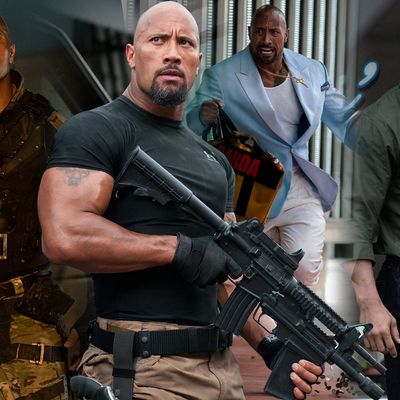
It’s not hard to smell what The Rock is cooking this summer — it’s box-office domination. With four movies released over the past four months (February’s Snitch, March’s G.I. Joe: Retaliation, April’s Pain & Gain, and this weekend’s Fast & Furious 6), the former WWE wrestling icon, otherwise known as Dwayne Johnson, has finally become cinema’s indisputable heavyweight stud.
Good luck finding anyone in the coveted 18–34 male demographic who doesn’t like, or at least appreciate, The Rock. Like his famous in-ring moniker, he’s now the People’s Champion, a gregarious superstar whose ubiquity — which also extends to recently headlining April’s Wrestlemania, as well as hosting an upcoming TNT reality series, The Hero — isn’t merely the result of the Hollywood machine deeming him marquee-worthy and force feeding him down the throats of audiences hungry for a post-Schwarzenegger superman. Instead, it’s a decisive reflection of his charisma and surprisingly deft abilities as both a tough guy and a comedian. Where so many others have failed, The Rock has thrived, blending steroidal heroics, a knowing smile, and his signature raised eyebrow in a manner that makes him seem at once formidable and approachable, ferocious and funny.
The Rock’s ownership of the first half of this year is the end result of a long process that took the better part of the past two decades. It began in the squared circle, where Johnson — having aspired to football greatness before injuries derailed his career at the University of Miami — first flailed as a featureless pretty boy before reimagining himself as The Rock, a tongue-wagging, smack-talking force of nature defined by hilarious catchphrases (“Jabroni,” “candy ass,” “If you smellllll what the Rock is cooking”) and a magnetic personality that made him the WWE’s defining star in the late nineties and early aughts. It was in that period that the key to Johnson’s success was first discovered: marrying brash, ass-kicking strength and intimidation with a knowing sense of humor. The joke was that Johnson got the joke of The Rock. At least initially, though, filmmakers, determined that his appeal lay mainly in the size of his biceps, and thus his early roles in The Mummy Returns (replete with an all-CGI Rock-spider creature for the grand finale) and its spinoff The Scorpion King merely utilized him as a featureless action-figure prop.
All that changed, somewhat stunningly, in 2003, with The Rundown, a film that — coming so early in his career, and given Hollywood’s already apparent desire to pigeonhole him in standard tough-guy roles — was tailor-made for his persona. With a jokey swashbuckling vibe, it allowed Johnson to bludgeon people silly (his character espousing a story-long aversion to guns) while also engaging in silly slapstick. Unlike in the more earnest Walking Tall, or his subsequent over-the-top turn in Richard Kelly’s Southland Tales, The Rundown seamlessly pitched Johnson as a self-aware action star, one who didn’t need to vacillate between modes from project to project (though he later would, flip-flopping from The Tooth Fairy’s family fun to Faster’s revenge mayhem); rather, he could be goofy and brutal simultaneously. When, early on in The Rundown, Arnold Schwarzenegger, in a cameo, tells him, “Have fun,” the anointment only seems like wishful thinking until the film kicks into gear, and it becomes clear that The Rock can more than shoulder the Terminator’s badass mantle.
And yet, even after that 2003 endeavor, Johnson’s big-screen career seemed stuck in second gear for the better part of the decade, defined by vehicles that never seemed to quite get the wink-winkness that underscored his endearing-behemoth appeal. That all began to change last year with Journey 2: The Mysterious Island, the sequel to Journey to the Center of the Earth, which, as with The Mummy Returns, proved that Johnson was the man to call on if you needed to save a series from Brendan Fraser. More importantly, however, it showed that he could be used as a plug-and-play improvement measure for any franchise. Hence Fast Five, which bested its predecessors almost exclusively because of Johnson’s participation and its embrace of his go-big-and-go-ridiculous charm. That film’s popularity, which was great enough to even reignite Vin Diesel’s fading career, has now begat this year, which finds Johnson not only continuing to keep the hot-rodding Fast and Furious series humming, but also commandeering another on-life-support series G.I. Joe, whose sequel Retaliation goes so far as to kill off its original headliner, the red-hot Channing Tatum, in order to fully hand the reigns to Johnson.
Still, it’s in Pain and Gain that, for the first time since The Rundown, Johnson finally manages to both embrace and lampoon himself in a role that requires both frenetic action and actual, you know, acting. With a self-consciousness mirrored, amazingly, by director Michael Bay, Johnson is all comic-book physique — at this point, his trapezius muscles are threatening to grow larger than his head — while at the same time mocking his size, and the violence it implies, with first born-again religious kookiness and then coked-out insanity. He’s a figure of outsize might that’s also a ridiculous caricature of that very virile strength. Rare is it for an action star to spoof that which most defines him, much less to the point that Johnson reaches in Pain and Gain, flexing his oiled-up body for the camera even as his character devolves into a degraded dope fiend snorting drugs off a stripper girlfriend’s ass and losing a toe to a gunshot as he flees the cops. Alongside innate and ineffable movie-star charisma, it’s that willingness to poke fun at himself that separates Johnson from the action-movie pack — and, ultimately, makes him contemporary action cinema’s perfect postmodern He-Man.

